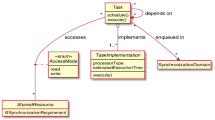Abstract
ATM technology placesstrict performance requirements on ATM systems, especially consideringthe scalability of the SDH/SONET physical layerto high speeds. Throughput preservation of the link speed throughprotocols to a higher layer application is a known problem inhigh-speed communication systems. The problem is being addressedwith design methodologies that offer high speed data paths, usingspecialized hardware, and increased processing power, commonlyin the form of embedded processors. In this paper, we presenta case study for a high-speed Queue Manager for ATM systems.The manager enables high-speed data transfer to/fromsystem memory and management of logical data structures (queues).Furthermore, it provides high-speed and importantly, scalabilityand re-usability, so that it can be used in a wide range of ATMsystems, such as workstation adapters, switches, routers, etc.In this work, we provide contributions in two directions. Wedescribe an approach to develop a high-speed, scalable and re-usablememory manager for ATM systems, and then we provide an architectureand implementations in harware as well as in software for embeddedsystems. The results indicate the cost/performancetrade-off's and system scalability and thus, enable designersto choose the implementation that meets their target system requirementswell.
Similar content being viewed by others
References
ATMizer Chip Family. LSI Logic. http://www.lsilogic.com/products/unit5_8a.html.
i960(R) Microprocessor User Guide for Cyclone and PCI-SDK Evaluation Platforms. INTEL Corporation. http://www.zettweb.com/CDROMs/cdrom004/DESIGN/I960/manuals/272577.htm.
MAX + PLUS II Getting Started. ALTERA.
ATM User-Network Interface Specification V3.1. ATM Forum, 1994.
Audiovisual Multimedia Services: Video on Demand Specification, V1.1. ATM Forum, March 1997.
MuQPro I Architecture Manual, internal working document. Technical report, ICS-FORTH, Crete, Greece, 1999. To appear on-line at a later date under the directory: http://archvlsi.ics.forth.com/muqpro/.
R. Ballart and Y-C. Ching. SONET: Now it's the standard optical network. IEEE Communications Magazine, pp. 8–15, March 1989.
F. Bonomi and K.W. Fendick. The rate-based flow control framework for the available bit rate ATM service. IEEE Network, 9(2): 25–39, March/April 1995.
M. Casoni and J. S. Turner. On the performance of early packet discard. IEEE Journal on Selected Areas in Communications, 15(5), June 1997.
IBM Corporation. Algorithm for Managing Multiple First-in, First-out Queues from a Single Shared Random-access Memory. Technical Report IBM Technical Disclosure Bulletin, Vol. 32, No 3B, August 1989.
R. Jain. Congestion control and traffic management in ATM networks: Recent advances and a survey. In Proceedings of the 4th International Symposium on High-Performance Computer Architecture (HPCA-4).
M. Katevenis, D. Serpanos, and E. Spyridakis. Credit-flow-controlled ATM for MP interconnection: The ATLAS I single-chip ATM switch. In Proceedings of the 4th International Symposium on High-Performance Computer Architecture (HPCA-4), Las Vegas, Nevada USA, pages 47–56, February 1998.
M. Katevenis, D. N. Serpanos, and E. Markatos. Multi-queue management and scheduling for improved QoS in communication networks. In Proceedings of the European Multimedia Microprocessor Systems and Electronic Commerce (EMMSEC'97), Florence, Italy, November 1997.
H. T. Kung and R. Morris. Credit-based flow control for ATM networks. IEEE Network, 9(2): 40–48, March/April 1995.
H. E. Meleis and D. N. Serpanos. Designing communication subsystems for high-speed networks. IEEE Network Magazine, pages 40–46, July 1992.
F. E. Ross, editor. Quantum Flow Control, V.2.0.5, QFC Alliance. March 26, 1997.
D. Serpanos. Communication subsystems for high-speed networks: ATM requirements. In In Asynchronous Transfer Mode, Proceedings of TRICOMM'93, Raleigh, NC, USA, pages 31–38, April 26- 27, 1993.
Verkest, D., et al. Matisse: A system-on-chip design methodology emphasizing dynamic memory management. Journal of VLSI Signal Processing, 21(3): 277–291, July 1999.
Wuytack, S., et al. Memory management for embedded network applications. IEEE Transactions on Computer-Aided Design, 18(5): 533–544, May 1999.
Author information
Authors and Affiliations
Rights and permissions
About this article
Cite this article
Serpanos, D.N., Karakonstantis, P. Efficient Memory Management for High-Speed ATM Systems. Design Automation for Embedded Systems 6, 207–235 (2001). https://doi.org/10.1023/A:1011250815826
Issue Date:
DOI: https://doi.org/10.1023/A:1011250815826




